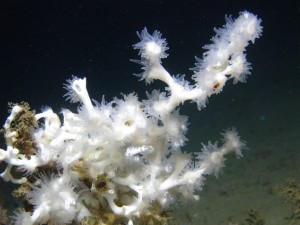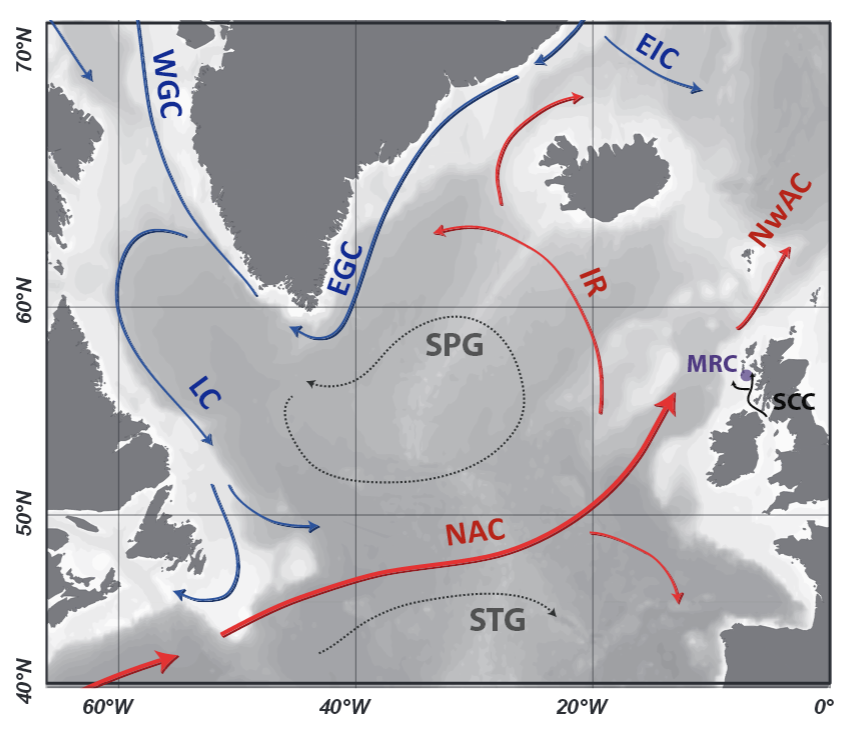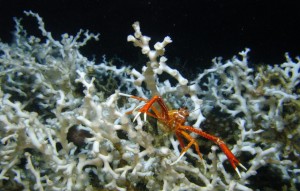13 January 2016
Ocean circulation changes may have killed cold-water corals
Posted by lhwang
By Lillian Steenblik Hwang
Successive and abrupt changes in North Atlantic ocean circulation over the past 4,500 years seem to have caused major reductions in some cold-water coral ecosystems, finds a study published in Geophysical Research Letters, a journal of the American Geophysical Union.

A close-up of the cold-water coral Lophelia pertusa, used in this study.
Credit: NOAA Ocean Explorer: Lophelia II 2009: Deepwater Coral Expedition: Reefs, Rigs, and Wrecks Exploration via Flickr
The new study shows changes in sea surface circulation over the last few thousand years were more sudden than previously thought and in some cases led to abrupt collapses of cold-water coral ecosystems. The researchers found the first evidence that perturbations in the Atlantic Meridional Overturning Circulation (AMOC) led to cold-water coral ecosystems decline from 100 to 1,200 years ago.
The new study shows cold-water reef ecosystems are sensitive to changes in climate and ocean circulation, potentially giving scientists insights into how these ecosystems could react to future changes in ocean circulation, according to the study’s authors.
A better understanding of how these vital ecosystems react to environmental changes could help policy makers determine how to protect these habitats, said Mélanie Douarin, a geoscientist in the Laboratory of Planetology and Geodynamics at the University of Nantes, France, and lead author of the new study.
Cold-water corals
When most people hear “coral reef,” they imagine a colorful tropical coral reef in warm, shallow waters. Cold-water corals are less well known. They aren’t as brightly colored as warm water coral reefs because they lack the symbiotic algae, zooxanthellae, warm-water reef species need to photosynthesize and that give them their vibrant colors.

A vibrant coral reef ecosystem at Palmyra Atoll National Wildlife Refuge.
Credit: Jim Maragos/U.S. Fish and Wildlife Service
Similar to tropical reef ecosystems, however, corals found in cold deep water are havens for biodiversity. Cold-water coral habitats are vital for fisheries and create safe and ideal shelter for many species of fish and invertebrates, according previous research. These habitats are also a potential source of novel new medicines, such as discodermolide, a cancer-fighting chemical produced by sponges growing on cold-water reefs, according to previous research.

The blackmouth catshark is just one of the many fish species that uses the Mingulay Reef Complex as a nursery.
Credit: Wikimedia Commons
Cold-water coral ecosystems are difficult to study, since they are often in waters too deep and frigid for scuba-divers. Most are found at depths ranging from 50 meters deep to more than 2,000 meters (160 feet to 6,500 feet) underwater and as cold as 4 degrees Celsius (39 degrees Fahrenheit). Environmental changes in these corals can be difficult to detect and monitor visually. Researchers must instead rely on historical records in the corals themselves to see how cold-water coral populations have changed over time.
Clues to the past
In the new study, researchers examined how cold-water corals have weathered changes in the environment during the past 4,500 years. They examined archived coral core samples taken from the Mingulay Reef Complex, a cold-water coral ecosystem located 120 to 190 meters (394 to 623 feet) below sea level off the coast of Scotland. They also took samples of the sediment on the ocean floor in the same area, and examined coral fragments sourced from those samples.
The researchers used uranium dating to determine the age of the coral samples and carbon dating to determine the relative age of the corals and the water they grew in. The age of the water mass surrounding the corals yields information on circulation changes in the ocean, Douarin said.
The new study found that during time periods when the AMOC — an important ocean circulation route that brings warm, salty, surface water from the tropics northward, and colder, deep ocean water south toward the tropics — was known to have changed, there was an absence of coral fragments in the samples taken. Changes in the AMOC can be caused by a variety of factors, such as changes in the winds blowing across the ocean’s surface and global differences in water density, ocean surface heat, and freshwater entering the ocean. The absence of coral fragments during periods when the AMOC changed indicates that corals in this area died or moved elsewhere due to changes in ocean circulation, according to Douarin.

The Mingulay Reef Complex (MRC) is located at the purple circle. Also shown are the major surface circulation features of the North Atlantic. The subpolar and subtropical (SPG and STG) waters mix and feed into the North Atlantic Current (NAC). Black arrows symbolize the Scottish Coastal Current (SCC). Red arrows show main branches of the warmer more saline North Atlantic Current (NAC), Norwegian Atlantic Current (NwAC) and Irminger Current (IR). Blue arrows show the main cooler fresher East Greenland Current (EGC), East Icelandic Current (EIC), West Greenland Current (WGC) and Labrador Current (LC).
Credit: Dourain et al
The new study does not address the factors that led to past coral population decline. Taking more coral samples in the future could create a more complete record of how corals have fared during the past 4,500 years. Coral data could then be directly compared with atmospheric records to find any correlations between changes in the ocean and the atmosphere, and the impact of those changes on cold water coral reefs, Dourain said.
Douarin hopes future researchers could create a more complete historical record of these habitats by examining variables such as water temperature, oxygen saturation or seawater carbon content to compare with coral samples or coral reef growth. A better understanding of how and why these reefs react to environmental change could help preserve these ecosystems.
Video footage above: Remotely operated vehicle (ROV) dives on the cold-water corals of the Mingulay Reef Complex Lophelia.org
— Lillian Steenblik Hwang is a science writing intern at AGU.











 GeoSpace is a blog on Earth and space science, managed by AGU’s Public Information staff. The blog features posts by AGU writers and guest contributors on all sorts of relevant science topics, but with a focus on new research and geo and space sciences-related stories that are currently in the news.
GeoSpace is a blog on Earth and space science, managed by AGU’s Public Information staff. The blog features posts by AGU writers and guest contributors on all sorts of relevant science topics, but with a focus on new research and geo and space sciences-related stories that are currently in the news.